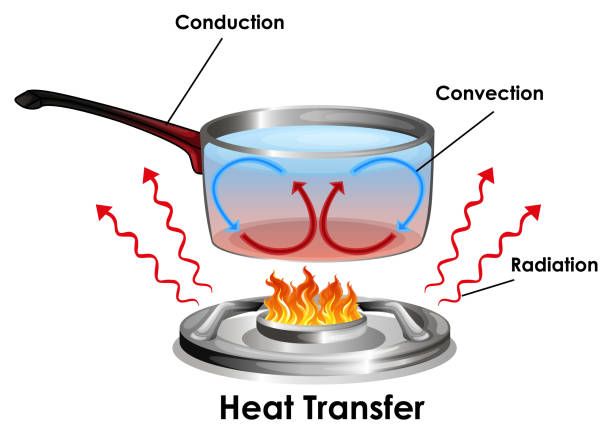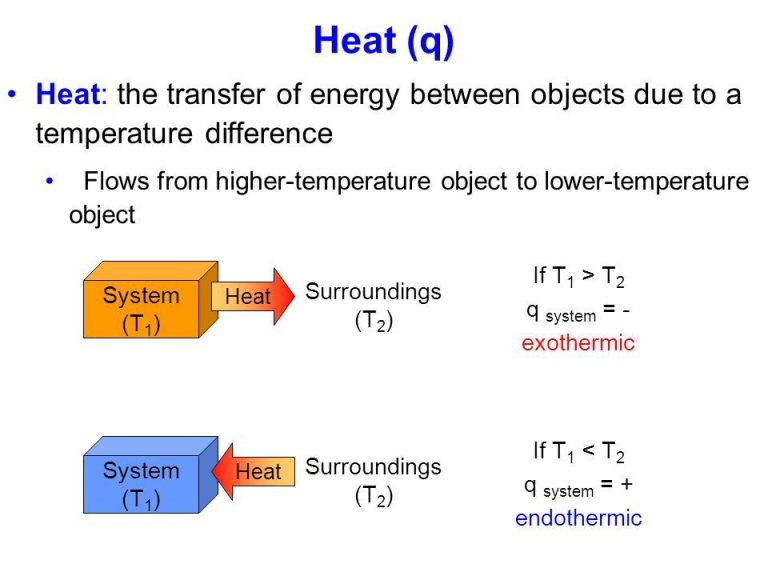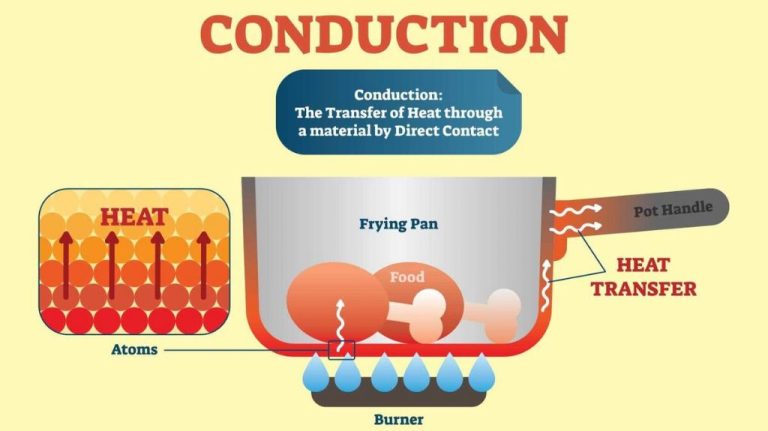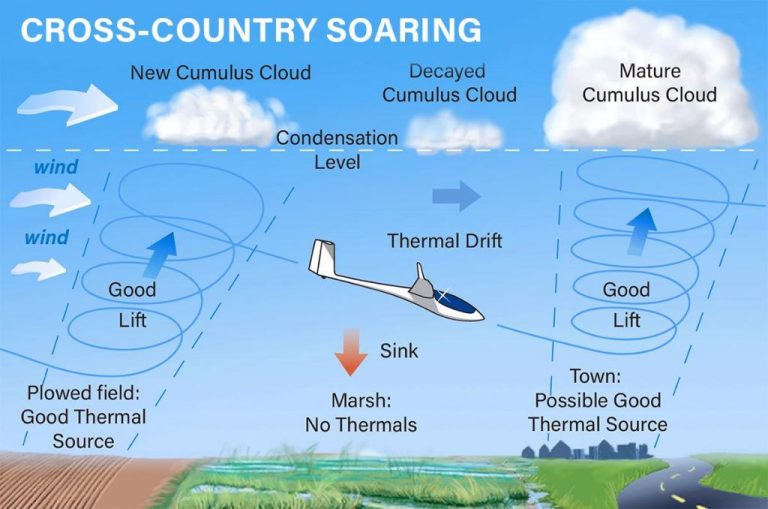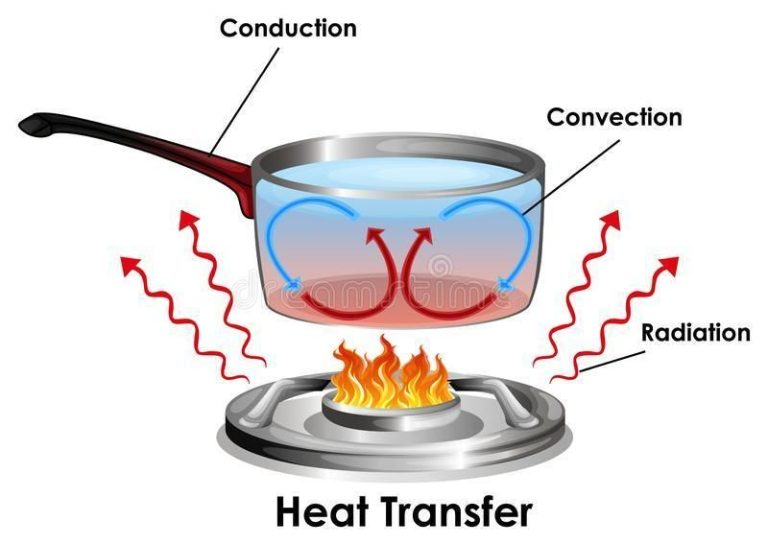What Are The Three Main Types Of Solar Thermal Power Systems?
Solar thermal power or Concentrating Solar Power (CSP) works by using mirrors or lenses to concentrate a large area of sunlight onto a small area to generate high temperatures that power a heat engine. The heat is
used to produce steam that drives a turbine generating electricity. Solar thermal plants can store thermal energy in tanks to produce electricity even when the sun isn’t shining.
The first solar thermal power plants were built in California during the 1980s. Since then CSP capacity has grown over 20 fold, led by investments in Spain and the US. Today most capacity comes from parabolic trough systems but tower and dish technologies are advancing. With ability to store energy solar thermal power delivers predictable renewable electricity and will play a major role in decarbonizing the electric grid.
The key benefits of solar thermal power are its ability to provide dispatchable renewable electricity, lowered electricity costs, enhanced energy security, and reduced greenhouse gas emissions. With thermal storage solar thermal plants can generate electricity on demand including during peak periods when electricity prices are highest.
Parabolic Trough Systems
Parabolic trough systems are one of the most common types of solar thermal power technologies. They consist of long, parabolic-shaped mirrors that concentrate sunlight onto a receiver tube running along the focal point of the trough. The concentrated sunlight heats a transfer fluid, typically a thermal oil, in the receiver tube to temperatures up to 750°F (400°C).
The hot fluid is then used to generate steam to power a traditional steam turbine generator and produce electricity. The cooled fluid is recycled through the system in a continuous loop.
The main components of parabolic trough systems include the parabolic-shaped reflector troughs, the receiver tubes, and a heat transfer fluid. The reflector troughs are generally made of glass with a reflective coating like silver or polished aluminum. The receiver tube is surrounded by an evacuated glass tube enclosure.
The conversion efficiency of parabolic trough systems ranges from about 15% to 30%. Systems can have capacities from 50 kW to hundreds of megawatts. Large-scale parabolic trough plants typically have capacities from 30 to 400 MW.
Parabolic trough power plants are one of the most economical solar thermal technologies. Their levelized cost of electricity ranges from 10 to 30 cents per kWh. Capital costs are around $5000 per kW of capacity.
Parabolic troughs are primarily used in large, grid-connected solar thermal power plants located in areas of high direct solar irradiation. Some of the largest parabolic trough plants are located in sunny desert regions of the southwestern United States, Northern Africa, and Spain.
Power Tower Systems
Power tower systems, also known as central receiver systems, use thousands of large, ground-mounted mirrors called heliostats to track the sun and reflect solar radiation onto a central receiver located atop a tall tower. The concentrated rays heat a working fluid inside the receiver to very high temperatures, up to 1000°F (538°C). The superheated fluid then flows through a heat exchanger where its thermal energy is transferred to water, generating high pressure steam to drive a turbine and produce electricity through a conventional steam generator.
The main components of a power tower system are the heliostat field with dual-axis tracking mirrors, the receiver, the thermal storage system, and the steam turbine generator set. The materials used include glass, aluminum, steel, and various high-temperature fluids like molten salt, water/steam, sodium, or air. Power tower systems can achieve high solar-to-electric efficiency of around 20-25%, with capacities ranging from 10-200 megawatts for a single tower plant.
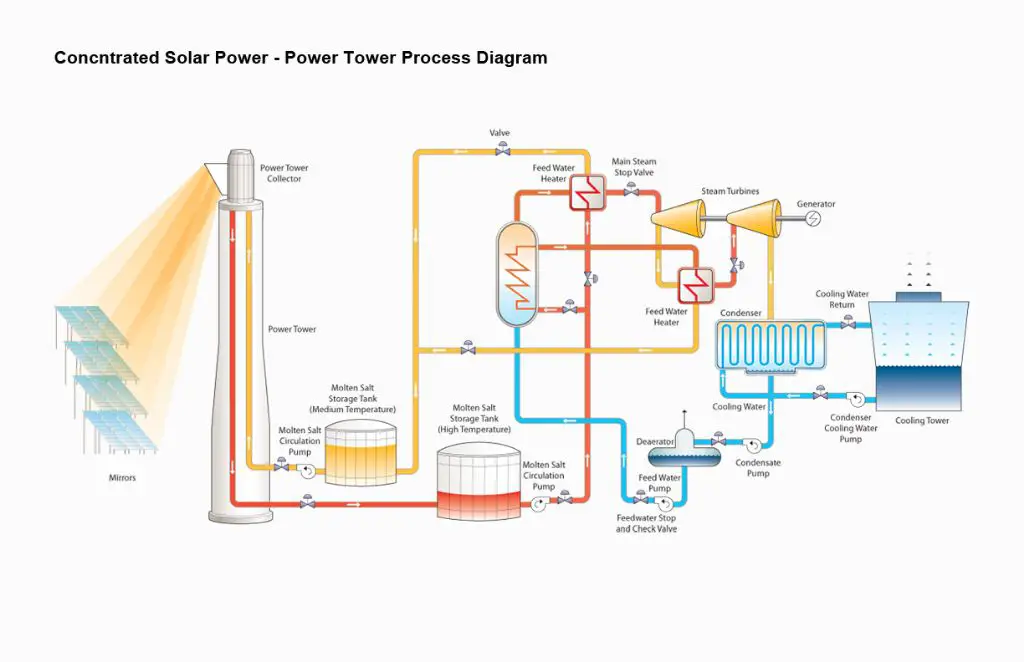
Recent larger projects utilizing power tower technology include the 377 MW Ivanpah plant in California and the 110 MW Crescent Dunes plant in Nevada. Costs range from $4-$8 million per installed megawatt, making power towers relatively more expensive than trough systems but with higher efficiencies. The main uses are utility-scale electricity generation and thermal energy storage. Ideal locations are in areas with high direct normal irradiation.
Parabolic Dish Systems
Parabolic dish systems are one of the main types of solar thermal power systems. They consist of a parabolic-shaped dish that reflects and concentrates sunlight onto a receiver at the focal point of the dish. The concentrated sunlight heats fluid in the receiver to very high temperatures, which is then used to generate electricity through a heat engine or turbine.
The dish structure is covered with mirrored facets that track the sun throughout the day, keeping the sunlight focused on the receiver. The receiver at the focal point of the dish contains tubes with fluid such as hydrogen or molten salt. The fluid is heated to temperatures of around 750–1,000°C. This high-temperature heat is used to generate steam that drives a turbine connected to an electrical power generator.
The main components of a parabolic dish system are the parabolic dish structure, the mirror facets, the tracking system, the receiver, and the power conversion system. The dish structures are usually made from a steel or glass fiber framework with foundations in the ground. The mirrors are coated glass or polished metal. The tracking system positions the dish using actuators to follow the sun.
Parabolic dish systems can reach high efficiencies of around 30% by concentrating sunlight to very high levels. However, each dish only has a capacity of up to 50 kW. The modular nature of dish systems means they can be built in small increments and located exactly where power is needed.
The costs of parabolic dish systems are higher than other CSP technologies, at around $7,000-$10,000 per kW. Their high efficiency makes them suitable for use in regions with high direct solar radiation. They have been deployed at demonstration projects and small-scale commercial plants in several regions such as the southwestern United States.
Comparisons
Each type of solar thermal power system has its own relative strengths and weaknesses in terms of efficiency, capacity, costs, and ideal use cases.
Parabolic trough systems tend to have lower efficiencies than power towers and dishes, typically around 15-25%. However, they can achieve larger capacities on the scale of 30-250 MW per plant. Their overall costs per kWh are moderate. Parabolic troughs work best for utility-scale power generation.
Power tower systems can reach higher efficiencies of around 15-30%, with capacities from 10-100 MW. However, their costs per kWh are generally higher. Power towers are ideal for supplementing the peak load capacity of power grids.
Parabolic dish systems achieve the highest efficiencies, up to 30%, but have smaller capacities of around 25 kW per unit. Their modularity makes them suitable for distributed power generation and off-grid uses. However, dishes have higher balance-of-system costs per kWh compared to large centralized plants.
In terms of pros, parabolic troughs offer proven large-scale generation, towers provide great peak load support, and dishes can meet remote power needs. Downsides are troughs’ lower efficiency, towers’ and dishes’ higher costs, and dishes’ small individual size.
Recent Innovations
Researchers and companies are constantly working to improve solar thermal technology and bring down costs. Some recent innovations include:
New reflective materials: New mirrored glass and reflective coatings can focus sunlight more efficiently onto the solar receiver. These materials increase the amount of solar energy converted into heat or electricity.
Hybrid designs: Hybrid solar thermal systems combine solar thermal technology with PV panels. The PV generates electricity to run the heat collection system, improving overall efficiency.
Advanced thermal storage: New thermal storage mediums like phase-change materials can store heat energy longer and release it when needed. This allows solar thermal plants to provide power even when the sun isn’t shining.
Lower-cost manufacturing: Automated manufacturing and simpler designs are bringing down the costs of key components like mirrors. This is making large-scale solar thermal systems more economically competitive.
Smaller-scale systems: New compact linear Fresnel reflector systems can generate solar thermal power on a smaller, distributed scale. This provides more flexibility.
Continued innovation in solar thermal technology will further improve the efficiency, storage capacity, costs, and scalability of these renewable energy systems.
Growth Projections
The solar thermal power industry is expected to see significant growth in the coming years as countries around the world work to expand renewable energy capacity and reduce carbon emissions. Total installed capacity for concentrated solar power (CSP), which includes the parabolic trough, power tower and dish/engine systems, is projected to reach 33 gigawatts (GW) by 2030, up from just over 6 GW at the end of 2019. This more than fivefold increase will be driven by continued cost reductions as well as supportive government policies.
Major capacity expansions are planned in China, South Africa, Morocco, Saudi Arabia and the United Arab Emirates. China aims to have 5 GW of solar thermal capacity by 2020 as part of its push to reduce coal dependence. South Africa has procured 1 GW of CSP as part of its renewable energy program. Middle Eastern countries are investing heavily in CSP to diversify their energy mix and build up domestic renewable capacity.
In addition, costs for building new CSP plants are expected to continue falling, making the technology more competitive. The levelized cost of energy (LCOE) for CSP is projected to decline around 35% by 2030. This is being driven by technology improvements, economies of scale, and lower operating costs. As costs decrease, CSP becomes more attractive for utilities and investors looking to add renewable energy capacity.
Challenges
While solar thermal power has great potential as a renewable energy source, there are some key challenges to wider adoption:
High upfront costs – Constructing solar thermal plants requires large capital investments, which can deter investors and project developers. This is especially true for new technologies that are not yet commercially mature.
Land usage – Solar thermal plants require significant amounts of land to capture enough solar radiation. This can make siting plants challenging, especially in densely populated areas.
Regulatory and policy barriers – In some markets, regulatory hurdles such as permitting issues or electricity market structures not optimized for solar may hamper growth. Supportive policies like tax incentives and renewable portfolio standards can help overcome these barriers.
Transmission constraints – The best solar resources are often located far from population centers, requiring expanded transmission infrastructure to deliver the electricity generated. Permitting and paying for new transmission lines is difficult.
Storage limitations – Most solar thermal plants today do not include cost-effective energy storage, forcing them to rely on natural gas co-firing or other techniques to generate power when the sun is not shining.
Water use – Many solar thermal designs require water for cooling or steam generation, which can strain supplies in arid regions.
Overcoming these challenges will take a combination of technology improvements, favorable government policies, and innovative business models. With the right strategies, solar thermal power can become a major sustainable energy source globally.
Environmental Impact
Solar thermal power has several important environmental advantages compared to fossil fuel power plants. Most significantly, solar thermal systems produce zero direct emissions of air pollutants like sulfur dioxide, nitrogen oxides, and particulate matter. They can help reduce greenhouse gas emissions from electricity generation when displacing fossil fuels.
In terms of water usage, solar thermal plants with parabolic trough or power tower systems require water for cooling and steam generation. But advanced plants can use dry cooling systems or hybrid wet/dry cooling to minimize water withdrawals. Parabolic dish systems require no cooling water. Proper plant siting is important to reduce impacts on local water resources.
Regarding land use, utility-scale solar thermal plants do require significant acreage. But the environmental footprint depends on factors like prior land use and whether sensitive habitats are avoided. With proper siting and wildlife protections, solar thermal’s overall habitat impacts can be limited. Furthermore, the land remains viable for other uses like grazing after decommissioning.
Conclusion
In summary, there are three main types of solar thermal power systems – parabolic trough systems, power tower systems, and parabolic dish systems. Parabolic trough systems use U-shaped mirrors to concentrate sunlight onto a receiver tube that runs along the focal line, heating up a heat transfer fluid inside. Power tower systems use a large field of flat mirrors (heliostats) to focus sunlight onto a central receiver tower, where molten salt or water is heated to very high temperatures. Parabolic dish systems use a dish-shaped reflector to concentrate sunlight onto a receiver at the focal point of the dish. The dish-shaped reflector tracks the sun in two axes to ensure optimal reception of sunlight. While each system has its own advantages and applications, all three can play an important role in the adoption of renewable energy.
Solar thermal power has significant potential for growth and innovation. Compared to solar photovoltaics, it can offer higher efficiency, built-in thermal storage capacity, and the ability to be hybridized with fossil fuels. With continued advances in thermal energy storage and cost reductions, solar thermal power is poised to grow substantially, complementing PV in decarbonizing the electricity sector. New innovations like solar chemical processes and concentrated solar thermoelectrics could further boost the value and versatility of concentrated solar power systems.
Overall, solar thermal power offers a promising renewable energy source to help phase out fossil fuel use for electricity generation. The three main types of concentrated solar power systems each have unique strengths that can address the challenges of intermittency and variability in solar output.

